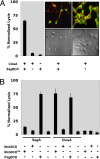Discovery of a widely distributed toxin biosynthetic gene cluster
- PMID: 18375757
- PMCID: PMC2311365
- DOI: 10.1073/pnas.0801338105
Discovery of a widely distributed toxin biosynthetic gene cluster
Abstract
Bacteriocins represent a large family of ribosomally produced peptide antibiotics. Here we describe the discovery of a widely conserved biosynthetic gene cluster for the synthesis of thiazole and oxazole heterocycles on ribosomally produced peptides. These clusters encode a toxin precursor and all necessary proteins for toxin maturation and export. Using the toxin precursor peptide and heterocycle-forming synthetase proteins from the human pathogen Streptococcus pyogenes, we demonstrate the in vitro reconstitution of streptolysin S activity. We provide evidence that the synthetase enzymes, as predicted from our bioinformatics analysis, introduce heterocycles onto precursor peptides, thereby providing molecular insight into the chemical structure of streptolysin S. Furthermore, our studies reveal that the synthetase exhibits relaxed substrate specificity and modifies toxin precursors from both related and distant species. Given our findings, it is likely that the discovery of similar peptidic toxins will rapidly expand to existing and emerging genomes.
Conflict of interest statement
The authors declare no conflict of interest.
Figures




Comment in
-
Morphing peptide backbones into heterocycles.Proc Natl Acad Sci U S A. 2008 Apr 15;105(15):5655-6. doi: 10.1073/pnas.0802300105. Epub 2008 Apr 8. Proc Natl Acad Sci U S A. 2008. PMID: 18398003 Free PMC article. No abstract available.
References
-
- Datta V, et al. Mutational analysis of the group A streptococcal operon encoding streptolysin S and its virulence role in invasive infection. Mol Microbiol. 2005;56:681–695. - PubMed
-
- Humar D, et al. Streptolysin S and necrotising infections produced by group G streptococcus. Lancet. 2002;359:124–129. - PubMed
-
- Nizet V. Streptococcal beta-hemolysins: Genetics and role in disease pathogenesis. Trends Microbiol. 2002;10:575–580. - PubMed
-
- Li YM, Milne JC, Madison LL, Kolter R, Walsh CT. From peptide precursors to oxazole and thiazole-containing peptide antibiotics: Microcin B17 synthase. Science. 1996;274:1188–1193. - PubMed
Publication types
MeSH terms
Substances
Grants and funding
LinkOut - more resources
Full Text Sources
Other Literature Sources
Molecular Biology Databases

